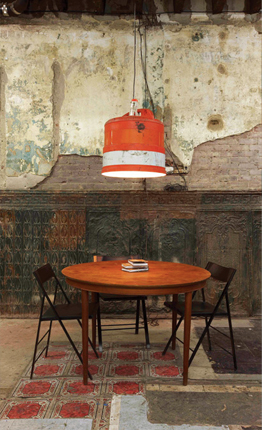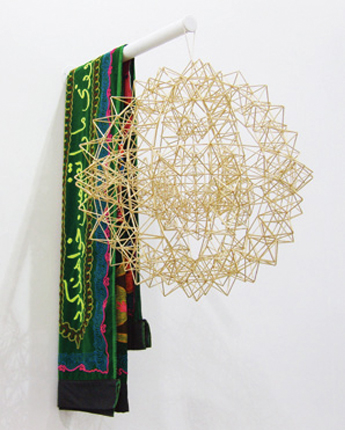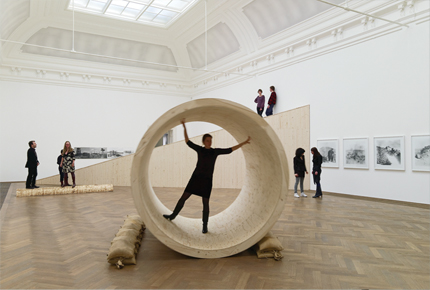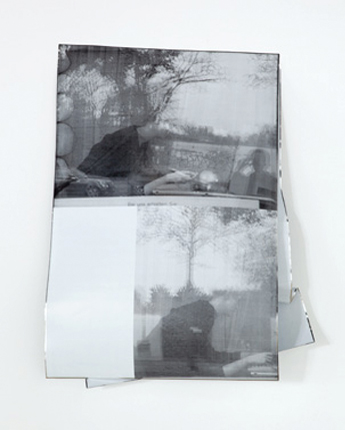Lidén / Issa / Slavs and Tatars / Macuga / Mauss
| May 8, 2012 | Post In LEAP 14

1. KLARA LIDÉN
Klara Lidén, a Berlin-based Swede working through installation, architectural interventions, and video, suffuses her practice with both the unbridled energy of a young urban adventurer and the resourcefulness of a hardened street urchin. Her work, resolutely, is “street”: via the reallocation of scavenged urban signifiers, such as posters, police barriers, a traffic barrel, or disused cardboard boxes, Lidén grapples with the psychological underpinnings of city life. Lidén’s most recent project, installed this winter at the Chinatown gallery Reena Spaulings, scavenges discarded Christmas trees from the streets of lower Manhattan. Taking in the sight is something of an elegiac ritual for New Yorkers, or a signal of the season in transition: every January, drying, fragrant Christmas trees litter street curbs, having been discarded after their once-sacred role in religious celebration. For her exhibition “Pretty Vacant,” Lidén takes these near-dead pine trees and stuffs them into Reena Spaulings, lit by “grow lights” (fluorescent lights commonly used to grow marijuana). A blue plywood wall, the sort often used to cordon off construction sites, separates the gallery office from the trees. In the center of the installation sits a heavily worn minimal geometric black leather couch, prompting the viewer to linger. Surprisingly, some tinsel and decoration remains intact on some trees. Some remain fragrant and verdant, while others struggle and succumb to browning.
Born in 1979 in Stockholm, Klara Lidén studied architecture at the Royal School of Technology in Stockholm and later, fine art at the University of the Arts in Berlin and Konstfack in Stockholm. She represented Sweden at the Venice Biennale in 2007, and will mount her first major US solo exhibition at the New Museum in May 2012, curated by Massimiliano Gioni. She is represented by Reena Spaulings, New York, and Galerie Neu, Berlin.

2. IMAN ISSA
Walking through the alleys of a foreign city is sometimes accompanied by the uncanny feeling of vague recognition— perhaps it is the way light hits a certain monument, or the proximity of a fountain to a nearby building— even if the odds of having been there are astronomically minimal. The Cairo-born artist Iman Issa takes these surreal moments as fodder, exhaustively documenting such moments of “recognition” through photography and video. For her “Triptychs” series, the artist pairs this documentation and creates settings consisting of three elements to parse out the associations and significance of the memories evoked by her documented places. The first element is the documentation itself; the second, a staged photograph of the memory evoked by the documentation; the third, a new artwork created in objective reflection of the two previous elements. Coming from a lineage of conceptual art oft-concerned with the politics of both commercial and exhibition-specific display, Issa’s “Triptychs” are rife with abstract referents that resist simplistic definition.
Represented by Rodeo Gallery in Istanbul, Issa has recently mounted solo exhibitions at Bielefelder Kunstverein, Germany; at Artissima 17, Turin, Italy; and at Rodeo. She was included in the second New Museum Triennial, “The Ungovernables,” curated by Eungie Joo, where she presented a new series of works titled “Materials” (2010-ongoing), a consideration of the commemorative language of memorials and monuments.

3. SLAVS AND TATARS
Although Slavs and Tatars have seemingly become omnipresent in the recent past, being featured in art and culture publications such as Fillip, 032c, Kaleidoscope, and Bidoun, as well as mounting exhibitions at institutions like the Tate and the New Museum, the collective is still an enigma to much of the Western art world. Formed in 2005, they describe themselves as “a faction of polemics and intimacies devoted to an area east of the former Berlin Wall and west of the Great Wall of China known as Eurasia.” Frequently working in institutional and public space, Slavs and Tatars engage media ranging from print publications to installation, sculpture, and two-dimensional work. While the collective reflects on all things Eurasia, they often do so with an Internet-sensitive vernacular, nearly enfants terribles, mercilessly collapsing the old with the new. The recent pitfalls of the Eurozone economic sector was their recent neon-and-prayer-rug installation at the Tate Modern’s Level 2 Gallery, part of “I Decided Not to Save the World,” held in collaboration with Salt, Istanbul. The monumental installation, titled “Mystical Protest,” read “It is of utmost importance that we repeat our mistakes as a reminder to future generations of the depths of our stupidity.”
Similarly ballsy was the collective’s PrayWay, a lounging bench-cum-flying carpet lit from its bottom with blue neon light. Presented at the New Museum’s “Ungovernables” triennial, PrayWay combines the disparate concerns of custom car culture and social and religious congregation. Slavs and Tatars are represented by Kraupa-Tuskany, Berlin, The Third Line, Dubai, and Raster, Warsaw, and in 2012 will mount solo exhibitions at Künstlerhaus, Stuttgart; Moravia Gallery, Bruno; Secession, Vienna; and MoMA, New York, where the collective’s work is in the permanent collection.

4. GOSHKA MACUGA
Part and parcel of her artistic practice, the Polish-born Goshka Macuga herself embodies the roles of archivist, anthropologist, architect, and curator, often wading through the bowels of the museum in search of content for ambitious, research-based projects. For the 2006 Bienial de São Paolo, Macuga was inspired by both the social fabric of Brazil and Oscar Niemeyer-designed building the biennial was installed in. Titled Mula sem Cabeça (The Headless Mule), the project consisted of an architectural component housing a collection of publications and artifacts, arranged non-hierarchically, on the colonial and broader social history of Brazil. Sitting at the bottom was a small patch of herbs locally believed to ward off evil spirits, supposedly used by past biennial participants.
In 2011, Macuga launched a solo meditation on artistic censorship at Warsaw’s Zachęta National Gallery of Art, taking an anomalous dark anecdote from Polish contemporary art history as a starting point: in 2000, the prominent Polish actor Daniel Olbrychski walked into Piotr Uklanski’s controversial exhibition, “The Nazis,” slashing several portraits of actors dressed as Nazi officials, confusing Uklanski’s critical standpoint for neo-Nazi propaganda. Titled “Around Censorship,” Macuga’s exhibition scoured the museum’s archive for past instances of artistic censorship in Poland.
Goshka Macuga is represented by Kate MacGarry, London; Rüdiger Schöttle, Munich; and Andrew Kreps, New York. She was shortlisted for the Turner in 2008, and, in addition to her 2011 exhibition at Zachęta, has recently mounted solo presentations at Walker Art Center, Minneapolis; Whitechapel, London; Kunsthalle Basel, Switzerland; and Mechelen, Belgium.

5. NICK MAUSS
In an era when contemporary art is largely over-determined, over-contextualized, and over-academicized, the work of Nick Mauss may seem out of place. The New York-based artist, often accused of lacking a contemporary style, uses drawing as a catalyst for his mostly two-dimensional practice, which includes screen-printing, photography, and occasionally ceramics. Drawing, the artist says, is “a kind of a secondary medium… A drawing rarely seems to be finished, it is a notation of an idea before it is set in place.” From the moment a drawing is completed, Mauss may step back from it and use it as objective material, and render it in another medium, perhaps via a primitive photographic technique or silkscreen. For a recent solo exhibition, Mauss meticulously splayed a portfolio of screen-printed aluminum sheets throughout 303 Gallery, as if a very diligent wind had just burst through the Chelsea space. Along with Mauss’ drawings or snapshots from his own collection, they accumulate in the space, appearing as the oversized pages of a nostalgic tome.
Mauss, who showed in the 2012 Whitney Biennial, is represented by Galerie Neu, Berlin, and 303 Gallery, New York. At age 25, in 2005, his work was acquired by the permanent collection of MoMA, New York. A 2003 graduate of the Cooper Union for the Advancement of Science and Art in New York, his recent solo exhibitions include “The desire for the possibility of new images” at 303 Gallery, New York; “Perforations” at Midway Contemporary Art, Minneapolis; “Reversible Surface” at Hiromi Yoshii, Tokyo; and “Disorder” at FRAC Champagne-Ardenne, Reims.

